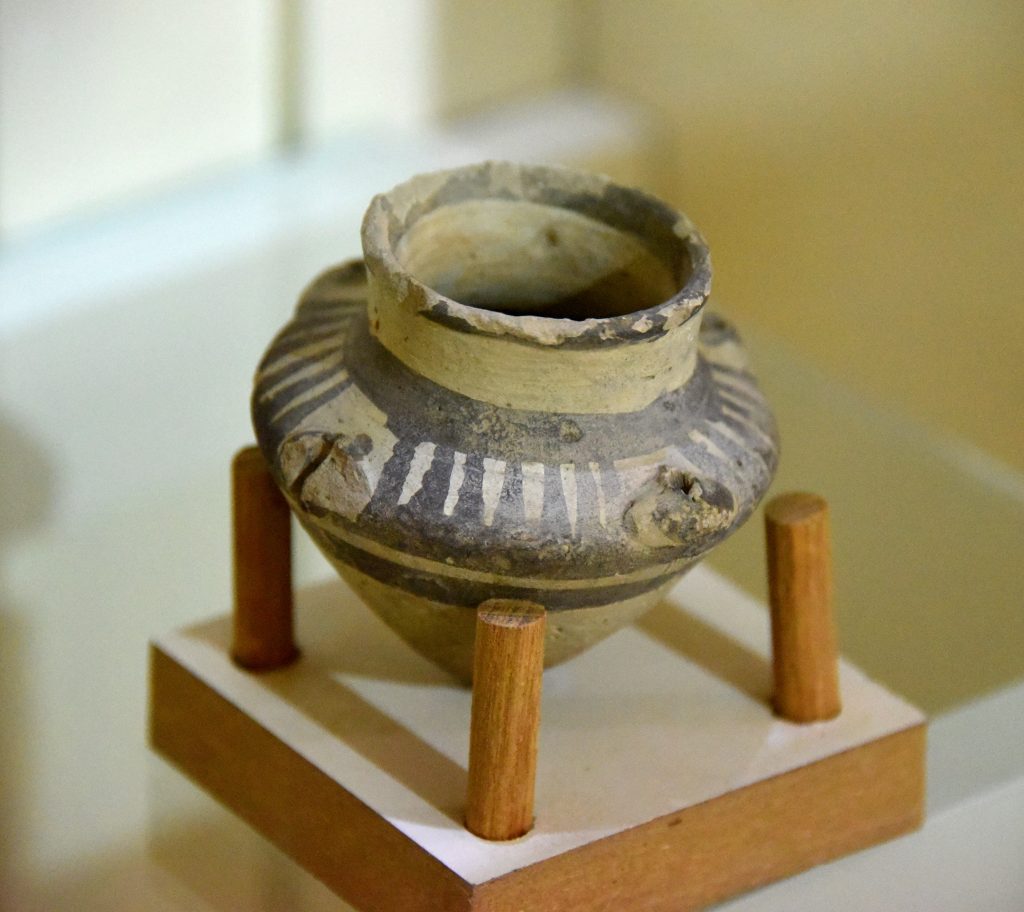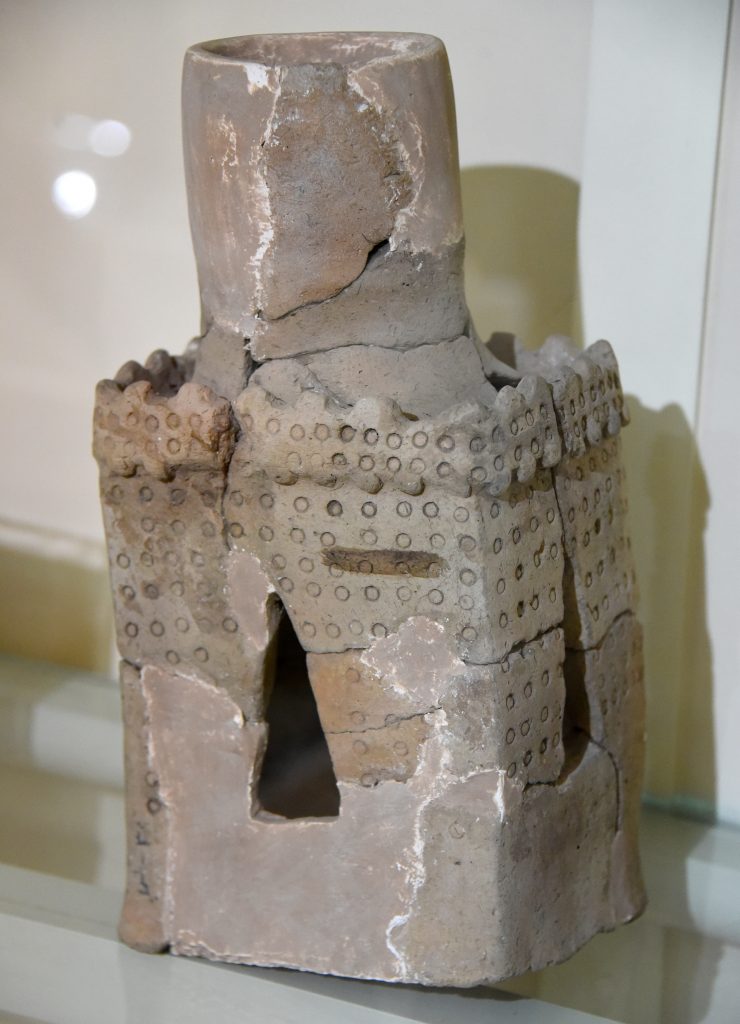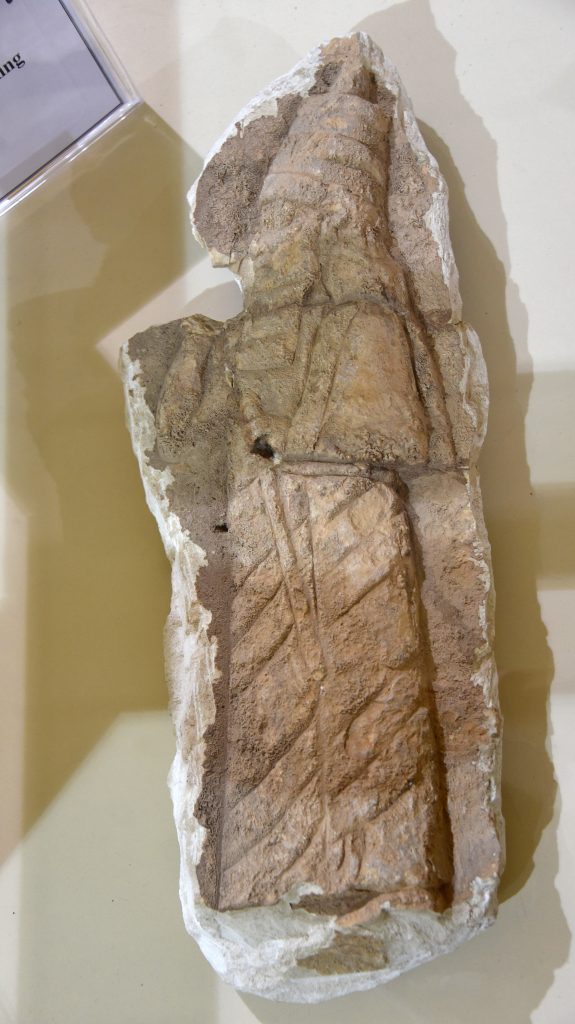I was attending a neurology event in Erbil (the ancient city of Arbela also known as Hawler in Kurdish), which is the capital city of Iraqi Kurdistan. The last time I had visited the Erbil Civilization Museum (Kurdish: موزه خانه ي شاره ستاني هه ولير ; Arabic: متحف أربيل الحضاري) was in September 2014. In comparison to the Sulaymaniyah Museum (the other archaeological museum in Iraqi Kurdistan), this museum is much smaller in terms of size and number of displayed antiquities. However, it has a considerable collection of interesting artifacts to view. The following is a tour of some of the museum’s highlights, which are little-known outside of Iraq.

Erbil Civilization Museum, Erbil Governorate, Iraqi Kurdistan. Photo © Osama S. M. Amin.
Entry is free and photography is allowed (without flash), but you have to obtain permission beforehand from the museum’s staff. I introduced myself and asked the museum to grant me permission in order take photos of the museum’s antiquities and publish them on Ancient History Encyclopedia (AHE).
History of the Museum
The idea behind the establishment of this museum goes back to mid-1960s. The museum’s building was relatively small, located in the Minarah district in Erbil, adjacent to the modern-day building of the Kurdish Parliament. It was administrated by the Erbil Archaeological Inspection Directorate.
In the 1960s, the museum housed and displayed only a few antiquities. During the mid-1970s, the museum was relocated to another building within the famous Erbil Citadel; it was connected to the General Directorate of Archaeology in Baghdad. Many antiquities (from the pre-historic era to the late Islamic period) were subsequently transferred from the Iraqi Museum in Baghdad to this museum.

Pottery tomb in the shape of an egg. Such tombs were used for the burial of children. From Tell Qaling Agha, Erbil, Iraqi Kurdistan, c. 3500-3100 BCE. Erbil Civilization Museum, Iraqi Kurdistan. Photo © Osama S. M. Amin.
Many artifacts excavated at Tell Qaling Agha are displayed to the public in a special case. (Tell Qaling Agha is an ancient tell (mound) within Erbil.) The rules and regulations at that time allowed each museum within Iraq to house and display only “one” excavated artifact if a group of artifacts was found within the museum’s governorate (or province). In 1985, during the Iraq-Iran War (1980-1988), the current museum’s building was completed. It was built in several stages and finalized in 1989, when the Museum’s staff and contents were relocated.
Exhibition Galleries
The building is divided into three halls:
- The ancient hall, which displays artifacts dating back to the Paleolithic Age, as well as the Jarmo, Halaf, Samara, Uruk, Eridu, Early Dynastic, Akkadian, Ur III, and Old Babylonian periods.
- The second hall houses artifacts from the Urartian, Hurrian, Middle and Neo-Assyrian, Seleucid, and Hatra periods; strangely, I couldn’t find a single item from the Neo-Babylonian period.
- The last hall contains antiquities from the Sassanian and Islamic periods with most belonging to the Abbasid period.

This is the first hall. Its displayed artifacts date from the pre-historic eras to the end of the third millennium BCE. Photo © Osama S. M. Amin.

This is the second hall. It houses artifacts from the Middle and Neo-Assyrian periods, Hurrian/Urartian periods, Seleucid period, and the ancient city of Hatra. The third hall, which is not shown, has artifacts from the Sassanian and early Islamic periods. Photo © Osama S. M. Amin.
Following the Iraqi invasion of Kuwait in 1990, the second Gulf War in 1991, the Kurdish uprisings in 1991, and local civil war during the mid-1990s, several archives and antiquities were unfortunately lost. Thus, the visitor will notice that many artifacts have no precise excavation site listed throughout the museum.
In this article, I have included photos of many artifacts, which I consider to be masterpieces of the museum, many of which are available for the very first time!
Artifacts from the Erbil Civilization Museum

Cutting blades and stones, which were found at the Paleolithic caves of Shanidar (in Erbil Governorate) and Hazar Merd (in Sulaymaniyah Governorate), which are both located in Iraqi Kurdistan. These date back to c. 60,000-45,000 BCE. Erbil Civilization Museum, Iraqi Kurdistan. Photo © Osama S. M. Amin.

Pottery jar made of unbaked clay. From Bard Hushtir village, Erbil Governorate, Iraqi Kurdistan. Jarmo period, c. 5,000 BCE. Erbil Civilization Museum, Iraqi Kurdistan. Photo © Osama S. M. Amin.

A group of marble bowls and jars. From Mesopotamia, modern-day Iraq; precise provenance of excavation is unknown. These date back to the Samara period, c. 5000 BCE. Erbil Civilization Museum, Iraqi Kurdistan. Photo © Osama S. M. Amin.

Painted pottery jar. From Mesopotamia, modern-day Iraq; precise provenance of excavation is unknown. This lovely piece dates back to the Halaf period, c. 4900-4300 BCE. Erbil Civilization Museum, Iraqi Kurdistan. Photo © Osama S. M. Amin.

Pottery boat model. From Mesopotamia, modern-day Iraq; precise provenance of excavation is unknown. This specimen dates back to the Eridu period, c. 4900-4300 BCE. Erbil Civilization Museum, Iraqi Kurdistan. Note the acquisition number “IM 17132”; this refers to the Iraqi Museum. Photo © Osama S. M. Amin.

Door socket. The cuneiform inscription on it mentions the name of the Neo-Sumerian king Shu-Sin (r. 2037-2029 BCE). From southern Mesopotamia, modern-day Iraq; precise provenance of excavation is unknown. Ur III era. Erbil Civilization Museum, Iraqi Kurdistan. Photo © Osama S. M. Amin.

This small pottery jar dates back to the Ninevite V period, c. 2900-2800 BCE. From Northern Mesopotamia, Iraq; precise provenance of excavation is unknown. Erbil Civilization Museum, Iraqi Kurdistan. Photo © Osama S. M. Amin.

Pig-shaped pottery. From Mesopotamia, modern-day Iraq; precise provenance of excavation is unknown. Early Dynastic Period, c. 2850-2350 BCE. Erbil Civilization Museum, Iraqi Kurdistan. Photo © Osama S. M. Amin.

Foundation cone inscribed with the name of Gudea, ruler of Lagash (r. 2144-2124 BCE). It was found in a temple at Girsu, modern-day Tell Telloh, Dhi Qar Governorate, Iraq. Erbil Civilization Museum, Iraqi Kurdistan. Photo © Osama S. M. Amin.

This pot and its lid were made of a black stone and were inscribed with cuneiform texts. From Mesopotamia, modern-day Iraq; precise provenance of excavation is unknown. It dates from c. 3000 BCE. Erbil Civilization Museum, Iraqi Kurdistan. Photo © Osama S. M. Amin.

Mud-brick inscribed with the name of the Neo-Sumerian king Ur-nammu (r. 2047-2030 BCE). From southern Mesopotamia, modern-day Iraq; precise provenance of excavation is unknown. Ur III period. Erbil Civilization Museum, Iraqi Kurdistan. Nota Bene: Take note of the Arabic word “نفر” on the right lower corner, written with a marker. It means “Nippur.” Nippur is one of the ancient Sumerian cities in southern Mesopotamia. The brick might well have been found there. Photo © Osama S. M. Amin.

Pottery incense burner. From Tell Basmosian, modern-day Lake Dukan, Sulaymaniyah Governorate, Iraqi Kurdistan. This artifact dates back to the Hurrian period, c. 1300-1000 BCE. Erbil Civilization Museum, Iraqi Kurdistan. Photo © Osama S. M. Amin.

Sandstone statue of an unknown standing and naked man or deity. From modern-day southern Kurdistan, Iraq; precise provenance of excavation is unknown. Urartian period, c. 1500 BCE. Erbil Civilization Museum, Iraqi Kurdistan. Photo © Osama S. M. Amin.

Clay hollow cylinder inscribed with cuneiform texts. From Mesopotamia, modern-day Iraq; precise provenance of excavation is unknown. Neo-Assyrian period, 911-612 BCE. Erbil Civilization Museum, Iraqi Kurdistan. Nota Bene: “ND 7100” can be recognized on the cylinder’s intact left bottom. I researched further and found that this is “Easarhaddon cylinder fragments from fort Shalmaneser, Nimrud.” It was found in the city of Nimrud and was housed in the Iraqi Museum, Baghdad. Please see Esarhaddon Cylinder Fragments from Fort Shalmaneser, Nimrud for more information. If you find any ancient artifact marked with the letters “ND” and a number, it means that these were excavated at the city of Nimrud (ancient Kalhu; Biblical Calah). Exclusive photo, never-before-published. Photo © Osama S. M. Amin.

An ivory plaque depicting a standing/striding bull, heading to the left. Part of the so-called “Nimrud Ivories,” which were excavated by Sir Max Mallowan between 1949-1963. From Nimrud, Mesopotamia, modern-day Iraq. This handsome specimen dates back to Neo-Assyrian period, 911-612 BCE. NB: This museum displays only three Nimrud ivory plaques, the other two are not shown here; one plaque depicts a standing creature, having a ram’s head and a human body and appears to wear the typical double crown of Egyptian pharaohs, while the other one is very worn and shows some body sitting among lotus flowers. All of these ivory plaques were originally housed in the Iraqi Museum in Baghdad. Erbil Civilization Museum, Iraqi Kurdistan. Exclusive photo, never-before-published. Photo © Osama S. M. Amin.

A fragment from a gypsum wall relief depicting the Assyrian king Sennacherib (r. 705-681 BCE). From northern Mesopotamia, modern-day Iraq; precise provenance of excavation is unknown. This artifact dates from the Neo-Assyrian period. Erbil Civilization Museum, Iraqi Kurdistan. Photo © Osama S. M. Amin.

A fragment of a wall relief which was carved with cuneiform inscriptions. Neo-Assyrian period, 911-612 BCE. Erbil Civilization Museum, Iraqi Kurdistan. Nota Bene: Mr. Qadri Ali, an archeologist, partially deciphered this text but he did not complete it. He said that the inscriptions mention the name of the Assyrian king Ashurnasirpal II (r. 883-859 BCE) and his military conflict with the Elamites. Site of excavation is unknown. Never-before-published, exclusive photo. Photo © Osama S. M. Amin.

From left to right: Life-size statue of an unknown leader or ruler from Hatra; a small statue depicting an unidentified deity but it might well represent the messenger god Hermes; small statue of an unidentified female deity; life-size statue of king Sanatruq I. From Hatra, modern-day Mosul Governorate, Iraq. These figures date back to the first century CE. Erbil Civilization Museum, Iraqi Kurdistan. Photo © Osama S. M. Amin.

Incantation pottery bowl with Aramaic text, thought to be used for religious ceremonies. From modern-day Iraq; precise provenance of excavation is unknown. Seleucid period, 312-139 BCE. Erbil Civilization Museum, Iraqi Kurdistan. Photo © Osama S. M. Amin.

Bronze oil lamp (lantern). From Aquban district, Shaqlawa village, Erbil Governorate, Iraqi Kurdistan. Early Christian period, c. 100-250 CE. Erbil Civilization Museum, Iraqi Kurdistan. Photo © Osama S. M. Amin.

A glazed glass jar. From modern-day Iraq; precise provenance of excavation is unknown. Sassanian period, 224-651 CE. Erbil Civilization Museum, Iraqi Kurdistan. Photo © Osama S. M. Amin.

A partially survived glazed glass plate. From modern-day Iraq; precise provenance of excavation is unknown. This lovely plate dates from the Abbasid period, 750-1258 CE. Erbil Civilization Museum, Iraqi Kurdistan. Photo © Osama S. M. Amin.

This is known as “Topzawa Rock or Topzawa Stele.” Topzawa is a village which lies within Erbil Governorate, northern Iraq. The stele was erected in Topzawa and looters transferred it to the Iraq-Iran border in order to sell it. The authorities captured it and it was transferred to the Erbil Citadel in Erbil and then to the museum. Unfortunately, this piece was greatly damaged. Each side was carved with cuneiform inscriptions. Few lines have survived, and but they could be recognized and deciphered. It appears that one side was Assyrian and the other one was Urartian. The rock narrates the military accomplishments of the Urartian king Rusas I and the clashes with the Assyrians. A very similar stele, Kel-a Shin stele, is housed in an Iranian museum; the stele mentions the acquisition of the city of Musasir by the Urartian king Ishpuini. Both steles were thought to be part of the kingdom of Musasir at Sidekan village, Erbil Governorate, Iraq. The village lies on the Iraqi side of the Iraq-Iran border. For more details, see Some Ancient Monuments on the Iraqi-Persian Boundary , an article by C. J. Edmonds written in 1966. Exclusive photo. Photo © Osama S. M. Amin.
I sincerely thank all of the museum’s staff and administration, especially Mr. Ahamd Jaodat (Director of the Museum) and Mr. Qadri Ali Abdullah (Curator and archaeologist) for their kind help and cooperation.
Disclaimer
Erbil (or Hawler) Governorate and Sulaymaniyah (or Slemani) Governorate lie within the northern area of Iraq and is part of modern-day Iraqi Kurdistan (or “Kurdistan Region” or “Southern Kurdistan”). All of these terms are used to describe the region. Neither the author nor Ancient History Encyclopedia (AHE) endorses any specific of the aforementioned terms.

